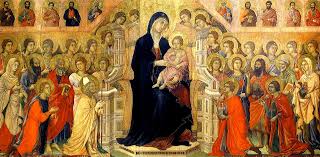
19 Nov TIO NYC: More Art, Low & High!
We are always on a high in New York- even when the art we are seeing goes low. Such was the case with “Oh Mary!” The high: also saw the show at the Met all about Sienese art and the rise of painting in the Western world.
Read on for more…

“Oh Mary! “at the Lyceum Theatre (through January 19.2025):

Mary Todd Lincoln was born December 13, 1818 in Lexington, Kentucky and died July 16, 1882 in Springfield, Illinois. She was an American first lady (1861–65), the wife of Abraham Lincoln, 16th president of the United States. Purportedly happy and energetic in her very privileged youth, she suffered subsequent ill health and personal tragedies, behaveing erratically in her later years.
Mary became First Lady on the eve of the Civil War, a challenging happenstance given her Southern, high birth and the fact some of her relatives (including her half brothers) were fighting for the Confederacy. Mary came to regard her duty as wife of the president as presenting an image of stability and respectability. To that end, she set about refreshing the White House and dressing in European-inspired haute attire. Her gracious performance as hostess initially drew praise, but was later criticized for what was perceived as extravagant spending. The death of Mary’s second son, Willie, in 1862 of typhoid fever added to the strain leading to reports about Mary’s off-piste behavior.
That irrational was on full peacock in “Oh Mary!” The dark comedy stars playwright Cole Escola as a miserable, suffocated Mary Todd Lincoln in the weeks leading up to her spouse’s assassination. Unrequited yearning, alcoholism and suppressed desires abound in this one-act comedy that finally examines the forgotten life and dreams of Mrs. Lincoln through the lens of an idiot (played by Escola).
“Cole Escola’s gleefully irreverent comedy is the funniest play in years…,” raved Time Out.
Irreverent indeed – and also way over the top. Way way. So funny for us just in moments, but over 80-minutes only consistently funny if slapstick and arch enough to drive a bus through it is your thing. And/or if you find four-letter words referring to body parts and events south of the belt line titillating. That said, the last act was stage magic: gritty, witty and tuneful. And throughout the super tight production, the five member ensemble was terrific.
Go here for a full-throated rave from The New York Times.
“Siena: The Rise of Painting” at The Met, through January 26, 2025!




All that glitters – is gold.
“Siena: The Rise of Painting” at The Met is a dazzling show – literally and metaphorically – what with all the gold on display on the walls and in display cases – also in the nuggets derived from the brilliant curation and commentary.
No other city outside Florence produced a comparably great school of painting, culminating in the figures of Duccio di Buoninsegna, the Father of Sienese Painting. All subsequent Sienese fine art from Simone Martini to the brothers Pietro and Ambrogio Lorenzetti had in Duccio a major mentor.
Duccio was clearly one of the most important painters of the 14th century and, like his slightly younger contemporary, Giotto, a major influence on the course of Western art. Clearly an innovator, Duccio introduced both the decorative, as well as the emotive through his use of line, color and pattern. In short, the man was a gifted storyteller clearly interested in expressing human emotions.
The Met sums up:
Siena: The Rise of Painting, 1300–1350 examines an exceptional moment at the dawn of the Italian Renaissance and the pivotal role of Sienese artists—including Duccio, Pietro and Ambrogio Lorenzetti, and Simone Martini—in defining Western painting. In the decades leading up to the catastrophic onset of the plague around 1350, Siena was the site of phenomenal artistic innovation and activity. While Florence is often positioned as the center of the Renaissance, this presentation offers a fresh perspective on the importance of Siena, from Duccio’s profound influence on a new generation of painters to the development of narrative altarpieces and the dissemination of artistic styles beyond Italy.
Drawing on the outstanding collections of The Met and the National Gallery, London, as well as rare loans from dozens of other major lenders, the exhibition includes more than 100 works by a remarkable group of Sienese artists. It features paintings alongside sculptures, metalwork, and textiles, ranging from large works made for public display to intimate objects created for private devotion. Although none of these artists survived the plague of circa 1350, their achievements had an immeasurable impact on painters and theorists in the centuries that followed…
A review by Holland Cotter for The New York Times beautifully sums up this beautiful, highly educational, must-see show.


Sorry, the comment form is closed at this time.